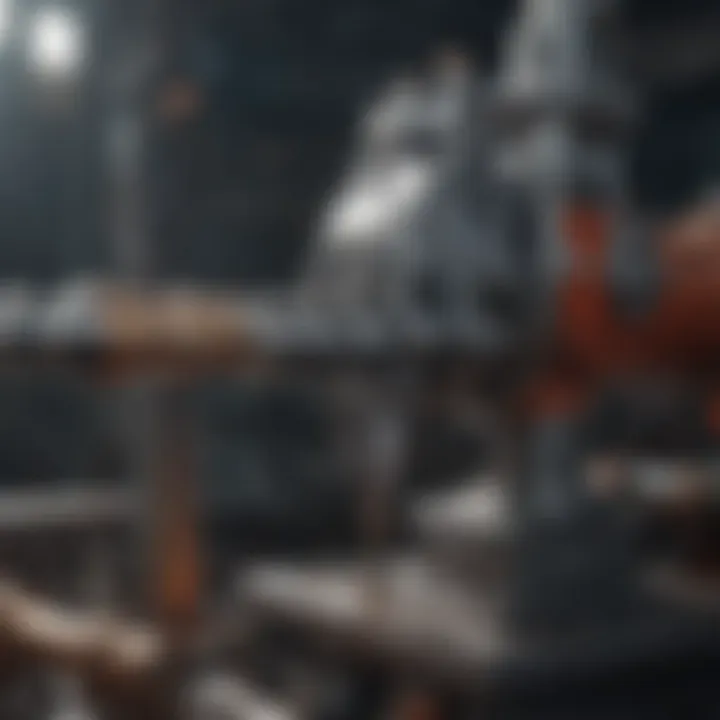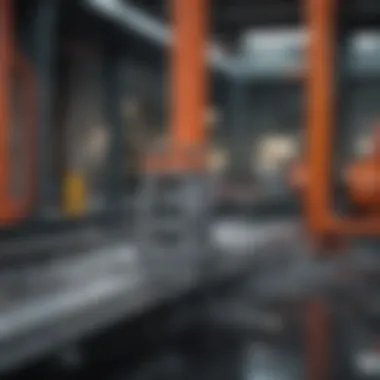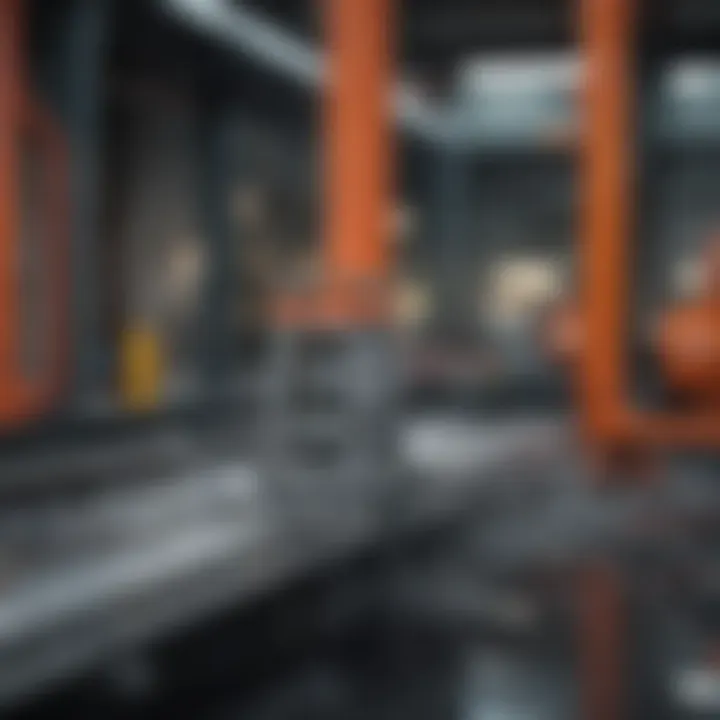Understanding Dewatering Extruders in Industry


Intro
In a world where efficiency and sustainability walk hand in hand, dewatering extruders are carving out an essential niche within modern industries. These machines utilize advanced technology to remove excess moisture from various materials, fundamentally transforming how industries manage solids and liquids. Whether in food processing, pharmaceuticals, or environmental services, the functionality of dewatering extruders cannot be overstated.
Dewatering extruders operate on the principle of combining mechanical pressure with thermal methods to separate liquids from solids. This process not only enhances material recovery but also significantly reduces waste. By transforming slurries and pulps into drier forms, these extruders facilitate better handling, transportation, and further processing.
As industries become increasingly aware of their environmental impact, the relevance of dewatering technologies grows. Processing waste more effectively and sustainably is no longer just a preference—it’s becoming a necessity. Businesses are keen to adopt practices that support resource management goals, making the exploration of these machines all the more timely and pertinent.
This article sets out to unpack the diverse aspects of dewatering extruders, from their operational mechanics to their broader implications in today’s industrial landscape. Expect to find insights on performance metrics, design considerations, and industry trends that elucidate the transformative role these machines play in advancing processing efficiency and supporting sustainability initiatives.
Through careful examination and analysis, we aim to provide students, researchers, educators, and professionals with a nuanced understanding of the significance and functionality of dewatering extruders, as they continue to pave the way for innovation in material processing.
Foreword to Dewatering Extruders
Dewatering extruders play a significant role in modern industry, enhancing efficiency and sustainability in material processing. Understanding their function is like peeling an onion; layer by layer, insights into their capabilities and impacts emerge. At their core, dewatering extruders are machines designed to remove water from various materials, primarily slurries or wet feeds. This has become increasingly crucial as industries face mounting pressures to optimize resource management and reduce waste.
These extruders are not merely tools; they're catalysts for innovation and efficiency. By effectively separating moisture from solid materials, they improve the handling and processing of raw materials, creating value at many levels. In sectors ranging from food processing to pharmaceuticals, dewatering extruders facilitate better product quality while minimizing environmental footprints. This alignment with sustainability initiatives cannot be overstated, as companies strive to meet regulatory demands and consumer expectations.
Definition and Overview
Dewatering extruders can be defined as specialized machines that utilize screw design and mechanical pressure to expel liquid, predominantly water, from wet materials. Operating on principles that combine heat, shear, and pressure, these machines effectively transform sludges, pastes, or other wet materials into solid forms with significantly reduced moisture content.
The operational concept behind these devices is relatively straightforward. A material is fed into the extruder, where it encounters a rotating screw mechanism. As the material travels through the barrel, heat is applied—often through electrical elements—simultaneously with mechanical force, promoting moisture extraction. Ultimately, the output is a dry product that is easier and more economical to handle.
Historical Context
The genesis of dewatering technologies can be traced back to traditional drying methods, which forced industries to rely on inefficient and often labor-intensive processes. Early drying techniques involved sun exposure or mechanical evaporation, but these methods lacked efficacy and consistency. As industrial processes evolved, especially during the 20th century, the need for more efficient drying systems spurred innovation.
By the time the 1980s rolled around, advancements in extrusion technology paved the way for dewatering extruders. Manufacturers began to recognize the benefits of combining screw extrusion with moisture removal techniques. Over the decades, these machines have undergone significant refinement, leveraging materials science and engineering advancements. Now, high-energy-efficient variants offer both cost savings and enhanced performance.
Ultimately, today’s dewatering extruders are a culmination of decades of development, designed to meet the industrial challenges of managing materials effectively while ensuring sustainability.
Operational Mechanisms
Understanding the operational mechanisms of dewatering extruders is essential for grasping their critical role in various industrial applications. These machines are designed to remove excess moisture from materials without compromising their structural integrity. The effectiveness of dewatering processes hinges on several factors, including the principles of how water is extracted and the specific components of the extruders themselves.
Principles of Dewatering
The foundation of dewatering lies in the principles of phase separation and moisture removal. Essentially, these processes can be described through two main methods: mechanical pressing and thermal processing. Mechanical pressing employs physical force to expel water, while thermal processing uses heat to join moisture vaporization into that mix, enabling efficient water extraction.
These principles highlight the significance of effective moisture management in industrial processes. By removing water content, materials can achieve better handling characteristics and prolonged shelf life. Furthermore, the energy costs associated with transporting water-laden materials are usually reduced, translating into substantial economic savings.
Components of Extruders
The functionality of dewatering extruders depends largely on their components, which work in tandem to efficiently effectuate moisture removal. Understanding these key components is crucial for recognizing how they function as a cohesive unit.
Feed System
The feed system serves as the starting point for the dewatering process, responsible for introducing materials into the extruder. One notable characteristic of this system is its ability to handle a diverse range of feed types, from granular substances to slurries. This versatility makes the feed system invaluable in various industries, whether it’s for food products or industrial waste.
A unique feature of the feed system is its auger design, which allows for smooth and controlled material transit. Effective feed systems often contribute to consistent processing by preventing blockages and ensuring an even distribution of materials. However, depending on the application, maintenance requirements may vary and include regular inspections and adjustments.
Screw Mechanism
The screw mechanism is the heart of the dewatering extruder, acting as both a conveyor and a processor. It is designed to transport materials through the extruder while simultaneously exerting pressure on them. A key characteristic of the screw mechanism is its ability to create a plug flow, which enables efficient grinding and mixing, crucial in achieving desired moisture content.
One unique aspect is the screw design; different pitches and diameters can influence the rate of material processing and moisture extraction. While this offers flexibility, extra care must be taken during setup and operation to avoid issues like material degradation or inconsistency in the end product.
Separation Unit
The separation unit plays a pivotal role in the dewatering process, separating dried materials from the moisture removed during extrusion. This component usually employs screens or filters to accomplish this task effectively. One major characteristic of this unit is its design, allowing for adjustable parameters to optimize water removal based on the feed material.


A special feature of today’s separation units is their ability to achieve higher levels of dewatering efficiency, sometimes combining multiple techniques such as centrifugation. While advantageous, challenges can arise, such as the need for frequent cleaning or the necessity of compatible materials to prevent clogging.
In summary, each component of the dewatering extruder plays a distinct role in ensuring successful moisture removal while contributing to overall processing efficiency. By understanding these operational mechanisms, industries can significantly enhance their production capabilities while also improving product quality and sustainability.
Types of Dewatering Extruders
Understanding the different types of dewatering extruders is paramount for anyone keen on optimizing processing methods in various industries. Each type comes with its own set of characteristics, benefits, and suitable applications. This section will delve into the nuances of single-screw and twin-screw extruders, and also explore the variations between batch and continuous systems.
Single-Screw Extruders
Single-screw extruders, as the name implies, utilize a singular screw for the dewatering process. These machines are often considered the standard in the industry, particularly because they’re relatively simpler in design and easier to maintain. The simplicity allows for better cost-effectiveness, making them a favorite among small to medium-sized operations.
One distinct advantage of single-screw machines is their ability to efficiently handle a range of viscosity levels. They are adept at processing materials that can be challenging for other systems. Moreover, they typically demand less energy, a significant benefit for companies striving to reduce operational costs.
However, this advantage comes with certain trade-offs. Single-screw extruders may struggle when it comes to blending multiple materials or handling high moisture content effectively. In applications where extensive mixing is necessary, they might not be the best fit.
Twin-Screw Extruders
In contrast, twin-screw extruders employ two interlocking screws, allowing for a more advanced mixing and conveying process. This design permits a more uniform distribution of heat and faster material transport. Hence, twin-screw models are often lauded for their enhanced processing efficiency.
These machines excel in batch applications where precise control over temperature and pressure is essential. They can accommodate a wide variety of feed materials, from low to high moisture content, and are more adept at combining substances. This flexibility is particularly important in industries like food processing and pharmaceuticals, where ingredient interactions can affect final product quality.
However, the complexity of twin-screw extruders could lead to higher maintenance costs. Additionally, their initial investment usually runs higher compared to single-screw models, which can be a deciding factor for budget-conscious operations.
Batch vs. Continuous System
When comparing batch and continuous systems, it’s crucial to highlight that each approach caters to specific production needs. Batch systems allow for processing materials in discrete quantities. This can be advantageous because it permits a high level of control and flexibility. Manufacturers can frequently switch formulations as needed without major disruptions.
However, the batch approach often involves longer downtimes between processes, affecting overall productivity. On the other hand, continuous systems facilitate uninterrupted operation, feeding materials to the extruder continuously. This leads to increased efficiency and lower operational costs over time.
Still, continuous systems may present challenges if sudden adjustments in production rates or formulas are needed, indicating a lesser flexibility in comparison to batch systems.
Applications in Various Industries
Dewatering extruders are a nexus around which many industrial processes revolve, connecting various sectors through their unique functionality. Their applications stretch from food processing to waste management, and even the pharmaceutical industry, showcasing both versatility and importance. Understanding these applications provides key insight into how industries can enhance operational efficiency, product quality, and sustainability.
Food Processing
In the food industry, dewatering extruders play a crucial role in enhancing product quality while assisting in the efficient removal of moisture. For instance, when producing textured vegetable protein, these extruders ensure that the raw materials are processed under controlled humidity levels, which is essential for maintaining the integrity and texture of the end product. The moisture content can make or break food quality; therefore, consistent dewatering leads to higher yields and better taste profiles.
Furthermore, many food companies are now focusing on sustainability. By integrating dewatering extruders, they not only minimize waste but also allow for better recovery of by-products. For example, when processing fruits and vegetables, dewatering can concentrate flavors and nutrients that might otherwise be lost.
Waste Management
The waste management sector is another significant area where dewatering extruders contribute substantially. They help reduce the volume of waste material, making disposal or recycling more efficient. Food waste, sewage sludge, and industrial waste can all be processed through dewatering extruders to separate solids from liquids. This process not only makes transportation easier and less costly but also enhances the potential for recycling.
Take, for instance, municipal sewage treatment plants that handle sludge. Using a dewatering extruder helps to lower the moisture content dramatically, thereby increasing the energy potential if incinerated or repurposed. Effectively, these machines transform a liability into an asset, allowing for new opportunities in energy recovery and resource reuse.
Pharmaceuticals
In the pharmaceutical industry, precision is paramount, and dewatering extruders meet this demand by providing a reliable method for processing active pharmaceutical ingredients (APIs). The quality of a drug is directly related to its purity, and the extruders help achieve a consistent moisture content necessary for the desired effectiveness of these APIs.
Moreover, they enable the development of controlled-release drug formulations by manipulating the moisture retention capacity of the materials. This capability, important in various drug delivery systems, further cements the role of dewatering extruders as indispensable tools in modern pharmaceutical processing.
Utilizing dewatering extruders across these varied industries signifies not just an improvement in processes but paves the way for innovation and sustainable practices. To underline this point, "Dewatering provides exceptional attention to material handling, allowing better control over the product lifecycle while conserving valuable resources." This fact underscores the critical role of these machines in advancing industrial sustainability and efficiency.
Advantages of Using Dewatering Extruders
Dewatering extruders serve an invaluable function in various industrial processes, leading to several notable advantages. Their operational mechanics have been fine-tuned to deliver results that significantly improve efficiency and reduce waste. In this section, we will delve into the primary benefits that dewatering extruders bring to the table, focusing on improved efficiency, enhanced material quality, and environmental benefits.
Improved Efficiency
The efficiency of dewatering processes directly influences overall production timelines and cost-effectiveness. Dewatering extruders streamline material handling by integrating multiple stages of processing into one continuous operation. This efficiency becomes evident through the following points:


- Reduced Processing Time: Traditional methods often involve multiple steps, which can delay product readiness. In contrast, dewatering extruders combine feeding, mixing, and dewatering in a single process, ultimately speeding up material throughput.
- Higher Throughput Rates: These machines can manage large volumes of material swiftly. This capacity is crucial for industries needing to handle significant amounts of waste or food products daily.
- Consistent Results: By employing a standardized mechanism, dewatering extruders provide uniform output quality. This predictability helps maintain production standards, resulting in less rework and waste.
Enhanced Material Quality
Quality assurance is a non-negotiable aspect of industrial processing, and dewatering extruders play a significant role in ensuring that the final product meets or exceeds quality expectations. Several factors contribute to this enhancement:
- Controlled Moisture Content: Improving the material's dryness is central to dewatering. Extruders manage the moisture levels effectively, leading to products that have longer shelf lives and better marketability.
- Improved Texture and Consistency: The mechanical pressure applied during the extrusion process can lead to a more homogenous texture, particularly important in food and pharmaceuticals, where consistency is key.
- Reduction in Contaminants: Good quality dewatering processes help eliminate unwanted residues and contaminations. This aspect is vital for meeting industry hygiene standards, thus enhancing safety and product integrity.
Environmental Benefits
In today’s eco-conscious landscape, the operations of dewatering extruders align well with sustainability goals. The benefits here are multifaceted:
- Waste Reduction: Dewatering extruders effectively minimize waste through their efficient use of materials, converting inputs into usable outputs while reducing the volume of refuse.
- Conservation of Resources: By maximizing material recovery, these systems encourage responsible resource use, decreasing reliance on raw materials and helping preserve the environment.
- Energy Efficiency: Modern dewatering extruders are designed to use energy more judiciously compared to traditional methods. Lower energy consumption translates into reduced operational costs and a lighter carbon footprint.
"Dewatering extruders offer a powerful solution to improve processes, produce higher quality outputs, and align industrial practices with sustainable principles."
Challenges and Limitations
Understanding the challenges and limitations of dewatering extruders is crucial for industries aiming to optimize their operations and resource management. While these machines offer significant benefits in various applications, they are not without their hurdles. An in-depth exploration of material compatibility, energy consumption, and maintenance requirements can shed light on the practical considerations needed when integrating dewatering extruders into existing processes.
Material Compatibility
Material compatibility is a fundamental concern that can greatly affect the performance of dewatering extruders. Different materials possess unique physical and chemical properties, which can influence how well they can be processed through an extruder. For instance, some polymers or waste products may not respond favorably to dewatering due to their viscosity or composition.
- Factors to consider:
- The physical state of the material: Some materials might be too viscous or contain too much moisture, resulting in inefficient processing.
- Chemical interaction: Compatibility testing may be needed to avoid degradation of materials.
Not considering these factors can lead to unexpected downtime and increased costs due to material wastage. Therefore, manufacturers must carry out thorough pre-assessment tests to ensure that their selected materials align with the operational capabilities of their chosen extruder, reducing the risk of running into problems down the line.
Energy Consumption
Energy consumption is another key challenge associated with dewatering extruders. These machines require significant amounts of power to operate effectively, presenting both operational costs and environmental considerations. The extent of energy usage can fluctuate based on:
- Operational settings: Different settings might require varying energy inputs, depending on the desired output.
- Machine age and efficiency: Older machines may consume more energy than newer, more efficient models.
To mitigate high energy usage, industries can explore energy-efficient alternatives or complementary technologies. Investing in advanced designs that optimize energy consumption not only helps in reducing costs but also contributes to sustainability targets.
Maintenance Requirements
Regular maintenance is essential to ensure the longevity and efficiency of dewatering extruders. These machines contain multiple moving parts, making them susceptible to wear and tear over time. Some key points to consider include:
- Routine Checks: Operators should conduct routine inspections to identify any potential issues before they escalate.
- Parts Replacement: Regular replacement of worn-out parts can prevent unexpected failures and costly repairs.
"Proactive maintenance is better than reactive maintenance. An ounce of prevention is worth a pound of cure."
Industries that ignore the maintenance needs of their dewatering extruders may face prolonged periods of inefficiency, leading to reduced throughput and financial loss. By prioritizing maintenance schedules and investing in training for personnel, companies can ensure their extruder systems function optimally, thereby reaping the full benefits of their initial investment.
Comparative Analysis with Other Technologies
Understanding the comparative analysis of dewatering extruders against other technologies is crucial for grasping their role in various industrial applications. This section will delve into the unique aspects, benefits, and specific considerations that set dewatering extruders apart from traditional and advanced methods. By examining the strengths and weaknesses of these technologies, one can appreciate the strategic advantages that extruders offer, especially in terms of efficiency and environmental impact.
Comparison with Traditional Methods
When we think about traditional dewatering techniques, processes like centrifugation and filtration often come to mind. These methods, while effective, might not always keep pace with the demand for efficiency and sustainability in modern industry. For instance, centrifugation, although widely used, can require significant power to operate effectively. Likewise, many filtration methods tend to struggle with post-processing, leading to longer processing times.
Dewatering extruders come into play as a more integrated solution. Here’s a straightforward comparison:
- Energy Efficiency: Dewatering extruders employ a continuous process that generally requires less energy compared to the batch processes often used in traditional methods. The energy savings can add up significantly, especially in large-scale operations.
- Material Integrity: Traditional methods can compromise the quality of sensitive materials. In contrast, extruders apply gentle pressure, minimizing damage and maintaining the material properties more effectively.
- Versatility: Unlike centrifuges and conventional filters, which may be limited to certain types of materials, dewatering extruders can adapt to a wider variety of inputs. Whether it’s sludge or food waste, their design allows for customization based on the feed materials.
Integration with Filtration Systems


The integration of dewatering extruders with existing filtration systems represents a significant advancement in material processing. When these two technologies work in tandem, the efficiency of the overall dewatering process can be drastically improved.
This integration often leads to:
- Enhanced Performance: Filters can remove fine particulates that extruders might struggle with alone. Together, they create a sequential process where dewatering extruders prepare the feed, followed by filtration that polishes the output.
- Reduction in Waste: Using both systems allows for better recovery of valuable materials. In sectors like pharmaceuticals and food processing, the precise removal of water content can lead to higher yields and less waste.
- Simplified Operations: Instead of relying on multiple disparate systems, utilizing an extruder in conjunction with a filtration unit can streamline operations. This can ultimately lead to reduced space requirements and simplified maintenance procedures.
Combining dewatering extruders with filtration not only boosts performance but also contributes to a more sustainable approach in handling industrial wastes.
The benefits of such an integrated system highlight the versatility and effectiveness of dewatering extruders when compared to traditional and standalone filtration technologies. As industry continues to evolve, the role of these machines in enhancing processing efficiency and environmental responsibility will only grow.
Future Trends in Dewatering Technologies
As industries across the globe continually seek ways to streamline processes and enhance sustainability, the evolution of dewatering technologies becomes increasingly vital. This section sheds light on the innovative strides being made in dewatering extruders, emphasizing the relevance of these advancements in contemporary industrial contexts. The enhancements focus on various elements, from design innovations to the integration of automation, all contributing to improved efficiency, reduced environmental impact, and enhanced processing capabilities.
Innovations in Design
Recent innovations in dewatering extruders are revolutionizing how materials are processed. The shift towards more sophisticated designs is not just about aesthetics; it's often about performance and efficiency. For instance, manufacturers are now experimenting with modular designs that allow for easy upgrades and maintenance. This flexibility can significantly enhance the longevity and adaptability of the equipment, ensuring it meets changing operational demands.
Another noteworthy development is the incorporation of advanced materials. These materials improve wear resistance and can handle a wider variety of feedstocks. With composite plastics and specialty alloys, these new designs can withstand harsher operational environments without succumbing to degradation. This consideration is vital, especially in industries like waste management, where equipment faces particularly abrasive substances.
Moreover, energy-efficient designs play a crucial role in reducing operational costs. Companies are focusing on reducing power consumption while maintaining performance levels, which leads to significant savings in both energy bills and environmental footprints. For example, prototypes that optimize the screw profile can enhance material throughput while requiring less energy.
"Innovations in dewatering extruder design not only enhance efficiency but also reduce the environmental footprint, making them pivotal in modern industrial processes."
Automation and Control Systems
The integration of automation and control systems is another pivotal trend in the dewatering industry. As tools become smarter, they allow operators to achieve higher levels of precision and oversight. Automation systems facilitate real-time monitoring and adjustments, which can drastically improve productivity and reduce material waste.
For instance, automated feed systems are quickly gaining traction. These systems can determine optimal feed rates based on the material's characteristics, ensuring a steady processing flow with minimal human intervention. This not only boosts efficiency but also diminishes the potential for human error, which can be costly in many industrial settings.
Additionally, control systems equipped with machine learning algorithms are now capable of predicting equipment malfunctions before they occur. By analyzing vast amounts of operational data, they can forecast maintenance needs and preemptively alert operators, reducing downtime and maintaining smooth operations.
Furthermore, the rise of IoT (Internet of Things) in manufacturing opens avenues for remote monitoring and control. Operators can oversee dewatering processes directly from mobile devices or computers, leading to increased responsiveness and flexibility.
In summary, future trends in dewatering technologies—centered around design innovations and automation—are shaping a landscape where efficiency and sustainability coexist. The evolution of these technologies is not merely an upgrade; it represents a foundational shift in how industries approach material processing and environmental stewardship.
The End
In summarizing the role of dewatering extruders in modern industry, it becomes apparent that their contributions transcend mere mechanical function. These systems represent a pivotal advancement in manufacturing processes, delivering significant benefits in terms of efficiency, material quality, and environmental impact. As industries grapple with increasing pressures for sustainable practices, the implementation of dewatering extruders emerges as a strategic choice.
Key Takeaways
- Efficiency Gains: Dewatering extruders optimally remove moisture, which shortens processing times and reduces the need for additional energy inputs. The result is a streamlined operation that not only lowers costs but also enhances output.
- Quality Enhancement: The process of dewatering facilitates the creation of higher-quality end products. By effectively controlling moisture levels, extruders help in achieving the desired characteristics in materials, particularly in sectors like food processing and pharmaceuticals.
- Environmental Advantages: This technology contributes to sustainability by minimizing waste. As industries face stricter regulations regarding waste management, adopting dewatering solutions can help meet compliance while promoting resource conservation.
- Versatile Applications: Dewatering extruders are not just for one type of material. They can efficiently handle a range of substances, from organic waste to food products, showcasing their versatility across various sectors.
"The evolution of dewatering technology has set new standards in material processing, leading industries toward a more sustainable future."
Implications for Industry and Research
The implications of utilizing dewatering extruders extend far beyond operational metrics. They pose critical questions for ongoing research and innovation.
- Innovative Research Directions: The demand for smarter, energy-efficient solutions is driving research into new designs and materials. The focus is shifting toward automation and advanced controls that optimize the dewatering process.
- Integration with Other Technologies: As industries aim for greater synergy in production lines, the integration of dewatering systems with existing filtration technologies is a notable trend. This fusion could lead to advancements in how materials are processed and handled.
- Long-term Sustainability Goals: The ability to minimize waste and enhance recycling efforts through dewatering processes is becoming increasingly vital. Industry players are recognizing this as a pathway to achieving long-term sustainability and compliance with environmental standards.
The growing emphasis on eco-friendly practices and operational efficiency underscores the need for continued exploration of dewatering technologies. With the irrefutable benefits they offer, dewatering extruders are set to play an ever more prominent role in shaping the future of industrial practices.
Academic Journals
Peer-reviewed publications are invaluable when exploring the functionality and advancements of dewatering extruders. Journals often provide rigorous analyses backed by experimental data and theoretical frameworks. These articles are essential for:
- Staying Current: New developments in technology and methodology are constantly emerging. Academic journals provide updates on the latest research that informs the direction of future innovations in dewatering systems.
- Validating Findings: When researchers draw conclusions concerning extruder performance or environmental impacts, referencing peer-reviewed studies substantiates those claims. This validation is crucial for educational purposes.
- Identifying Gaps: Academic literature often highlights areas needing further exploration. This can guide industry players in improving existing processes or developing novel technologies.
"The best research is built upon the foundation laid by past scholars; understanding their findings can accelerate future breakthroughs."
Industry Reports
Alongside academic articles, industry reports play a key role in providing practical insights. Often produced by market research firms or industry leaders, these reports deliver:
- Market Trends: Insights into how dewatering extruders are being utilized across various sectors can inform decisions on investment or shifts in production methods.
- Technical Specifications: Industry reports typically contain information about the latest models, including materials, energy consumption, and efficiency metrics. Such data is crucial for manufacturers assessing the viability of new machines.
- Case Studies: Real-world examples from industries using dewatering extruders can demonstrate proven success or areas for improvement. These accounts can offer practical guidance to others looking to adopt similar technologies.
Utilizing both academic journals and industry reports enables a holistic understanding of dewatering extruders, bridging the gap between theoretical knowledge and practical application.















